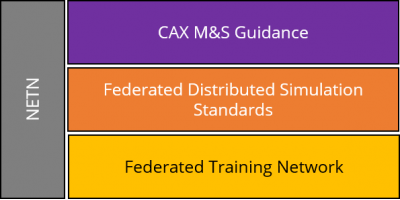Vision
To deliver to NATO and Partners a persistent, distributed and joint training capability able to support training from operational to tactical level across the full spectrum of operations, whilst leveraging existing national expertise and capabilities.

In 2006, NATO Allied Command Transformation (ACT) requested NATO Modelling and Simulation Group (NMSG) to explore the concepts of a NATO Education and Training Network capability. An exploratory team (ET-025) was set up to analyze the requirement and it proposed a technical activity to develop the NETN concepts.
In 2007, the NMSG technical activity MSG-068 NETN was started. The group was led by NATO Joint Warfare Center (JWC) and with participants from NATO HQ-SACT, NATO Joint Forces Training Center (JFTC), NATO Consultancy, Command and Control Agency (NC3A) and 13 Nations (Australia, Bulgaria, France, Germany, Hungary, Netherlands, Romania, Slovenia, Spain, Sweden, Turkey, UK, USA). MSG-068 assessed the distributed simulation and learning capabilities that could contribute to the development of an NETN capability and drafted standards to better enable reuse and sharing of national Modelling and Simulation systems.
The key MSG-068 outputs were; 1) the recommendation to use CFBL-net as the managed IP-network on which NETN distributed simulation and exercises should run, and 2) a NETN Federation Architecture and FOM Design specification (NETN FAFD) defining a reference model for how NETN simulations interoperate.
ACT later renamed the NETN program to "Snow Leopard" and "Distributed Training and Exercises (DTE)" but the vision remain the same and is aligned with the Connected Forces Initiative (CFI) for Smart Defence.
In early 2012, the NMSG technical activity MSG-106 SPHINX was started as a follow-on to MSG-068. The group delivered three (3) draft Allied Modelling and Simulation Publications (AMSP):
- A standards profile for Computer Assisted eXercises (CAX) (AMSP-03)
- An updated NETN FAFD (AMSP-04).
- A handbook for developing CAX with simulation (AMSP-05)
In late 2014, the NMSG technical activity MSG-134 NATO Distributed Simulation Architecture & Design, Compliance Testing and Certification was started as a follow-on for continued maintenance and to support the formal release of AMSP-04 NETN FAFD covered by STANREC 4800. In addition, MSG-134 work on establishing the NATO HLA certification process identified in STANAG 4603 and tools to support integration, test and verification of standards compliance (IVCT).
In 2018, the NMSG technical activity MSG-163 Evolution of NATO Standards for Federated Simulation was started to continue maintenance of AMSP-04 and futher extend the federation agreements to include additional modules and results from other technical activities related to federated simulation. MSG-163 also work to improve the HLA Certification process and supporting tools.
